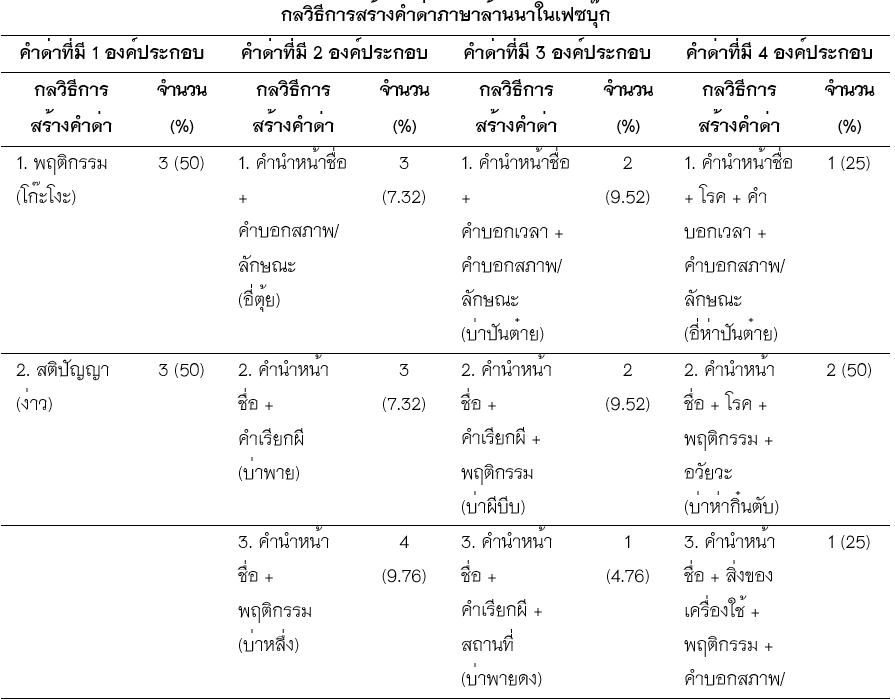Word Formations of Lanna Swear Words in Facebook
Keywords:
Word Formations, Swear Words, Lanna Language, FacebookAbstract
This article aims to analyze word formations of Lanna swear words in Facebook. The data were collected from swear words in comment sections on Facebook page ‘Meang Ngaw’ from January 2018 to December 2018. There were 72 Lanna swear words. The data was analyzed and the results were presented by descriptive analysis and percentage.
The findings revealed that there were 4 main types of word formations: 1) a swear word formed by 1-word part 2) a swear word formed by 2-word parts 3) a swear word formed by 3-word parts and 4) a swear word formed by 4-word parts. Each main type was classified into 2 subtypes, 21 subtypes, 15 subtypes, 3 subtypes, respectively. When considering 4 types of word formations, it was found that swear words formed by 2-word parts was the largest types of word formation (56.94 %) followed by swear words formed by 3-word parts (29.17 %), 1-word part (8.33 %) and 4-word parts (5.56 %), respectively.
References
ธัญญากร บุญมี และอัศวิน เนตรโพธิ์แก้ว. (2561). อัตลักษณ์เสมือนกับการปฏิสัมพันธ์ทางสังคมบนเครือข่ายสังคมเกมออนไลน์. วารสารมนุษยศาสตร์และสังคมศาสตร์ มหาวิทยาลัยพะเยา, 6(1), 82-95.
ปิ่น มุทุกันต์. (2541). พุทธวิธีครองใจคน. กรุงเทพฯ: สร้างสรรค์บุ๊คส์.
ราชบัณฑิตยสถาน. (2556). พจนานุกรม ฉบับราชบัณฑิตยสถาน พ.ศ. 2554 (พิมพ์ครั้งที่ 2). กรุงเทพฯ: ศิริวัฒนาอินเตอร์พริ้นท์.
รุ่งอรุณ ทีฆชุณหเถียร. (2529). ที่ว่าหยาบนั้นฉันใด. มนุษยศาสตร์สังคมศาสตร์ มหาวิทยาลัยขอนแก่น, 5(2), 110-119.
วิสันต์ สุขวิสิทธิ์. (2547). วัจนกรรมการบริภาษในภาษาไทย. (วิทยานิพนธ์อักษรศาสตรมหาบัณฑิต). กรุงเทพฯ: จุฬาลงกรณ์มหาวิทยาลัย.
วีระศักดิ์ บุญญาพิทักษ์. (2536). คำบริภาษในเพลงชาน้อง. (วิทยานิพนธ์ศิลปศาสตรมหาบัณฑิต). สงขลา: มหาวิทยาลัยสงขลานครินทร์.
ศรศักดิ์ ไชยมงคล. (2540). ลักษณะการบริภาษในวรรณคดีประเภทกลอนบทละครและกลอนนิทานสมัยรัตนโกสินทร์ตอนต้น. (วิทยานิพนธ์การศึกษามหาบัณฑิต). มหาสารคาม: มหาวิทยาลัยมหาสารคาม.
ศราวุธ หล่อดี. (2558). โลกทัศน์ของชาวไทลื้อที่สะท้อนจากคำประสมที่มีคำว่า ‘หัว’ ในภาษาไทลื้อ. วารสารวิชาการมหาวิทยาลัยฟาร์อีสเทอร์น, 9(2-4), 46-62.
ศราวุธ หล่อดี. (2561). คำเรียกสีและมโนทัศน์เกี่ยวกับสีในภาษาล้านนา. (วิทยานิพนธ์ศิลปศาสตรดุษฎีบัณฑิต). พะเยา: มหาวิทยาลัยพะเยา.
สมบูรณ์ ศรีระสันต์. (2542). วิเคราะห์ค่านิยมทางสังคมและการใช้ภาษาจากคำบริภาษในบทละครนอกพระราชนิพนธ์พระบาทสมเด็จพระพุทธเลิศหล้านภาลัย. (ปริญญานิพนธ์การศึกษามหาบัณฑิต). สงขลา: มหาวิทยาลัยทักษิณ.
แหย็ม โฆล่า. (2533). คำหยาบ: ที่มาและบทบาทของคำหยาบในภาษาไทยกลาง. กรุงเทพฯ: เจริญวิทย์การพิมพ์.
อรทัย ชินอัครพงศ์. (2557). การศึกษาคำด่าในภาษาไทยตามแนวอรรถศาสตร์ชาติพันธุ์และวัจนปฏิบัติศาสตร์. (วิทยานิพนธ์ศิลปศาสตรดุษฎีบัณฑิต). พิษณุโลก: มหาวิทยาลัยนเรศวร.
อมรา ประสิทธิ์รัฐสินธุ์. (2522). สมมติฐานซาเพียร์-วอร์ฟ. วารสารอักษรศาสตร์, 11(2), 20-32.
อุดม รุ่งเรืองศรี. (2547). พจนานุกรมล้านนา-ไทย ฉบับแม่ฟ้าหลวง. เชียงใหม่: มิ่งเมือง.
Allan K, Burridge K. (1991). Euphemism and Dysphemism: Language Used as Shield and Weapon. New York: Oxford University Press.
Sapir E. (1949). The Status of Linguistics as a Science. In Culture, Language, and Personality: Selected Essays. Berkeley and Los Angeles, California: University of California Press, 69.
Whorf BL. (1956). An American Indian model of the universe, The relation of habitual thought and behavior to language. In Language, Thought, and Reality: Selected Writings of Benjamin Lee Whorf. Cambridge, Mass.: M.I.T. Press., 57-64, 135.

Downloads
Published
How to Cite
Issue
Section
License
Copyright (c) 2021 Phayao University

This work is licensed under a Creative Commons Attribution-NonCommercial-NoDerivatives 4.0 International License.
ผู้นิพนธ์ต้องรับผิดชอบข้อความในบทนิพนธ์ของตน มหาวิทยาลัยพะเยาไม่จำเป็นต้องเห็นด้วยกับบทความที่ตีพิมพ์เสมอไป ผู้สนใจสามารถคัดลอก และนำไปใช้ได้ แต่จะต้องขออนุมัติเจ้าของ และได้รับการอนุมัติเป็นลายลักษณ์อักษรก่อน พร้อมกับมีการอ้างอิงและกล่าวคำขอบคุณให้ถูกต้องด้วย
The authors are themselves responsible for their contents. Signed articles may not always reflect the opinion of University of Phayao. The articles can be reproduced and reprinted, provided that permission is given by the authors and acknowledgement must be given.







